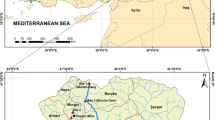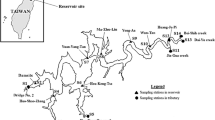Abstract
The present study was intended to develop a Water Quality Index (WQI) for the coastal water of Visakhapatnam, India from multiple measured water quality parameters using different multivariate statistical techniques. Cluster analysis was used to classify the data set into three major groups based on similar water quality characteristics. Discriminant analysis was used to generate a discriminant function for developing a WQI. Discriminant analysis gave the best result for analyzing the seasonal variation of water quality. It helped in data reduction and found the most discriminant parameters responsible for seasonal variation of water quality. Coastal water was classified into good, average, and poor quality considering WQI and the nutrient load. The predictive capacity of WQI was proved with random samples taken from coastal areas. High concentration of ammonia in surface water during winter was attributed to nitrogen fixation by the phytoplankton bloom which resulted due to East India Coastal Current. This study brings out the fact that water quality in the coastal region not only depends on the discharge from different pollution sources but also on the presence of different current patterns. It also illustrates the usefulness of WQI for analyzing the complex nutrient data for assessing the coastal water and identifying different pollution sources, considering reasons for seasonal variation of water quality.













Similar content being viewed by others
Abbreviations
- WQI:
-
Water Quality Index
- CA:
-
Cluster analysis
- DA:
-
Discriminant analysis
- PCA:
-
Principal component analysis
- FA:
-
Factor analysis
- DO:
-
Dissolve oxygen
- NH3-N:
-
Ammonia nitrogen
- NO3-N:
-
Nitrate nitrogen
- PO4-P:
-
Phosphate phosphorus
- BOD:
-
Biological oxygen demand
- TSS:
-
Total suspended solids
References
Akoteyon, I. S. (2013). Evaluation of groundwater quality using water quality indices in parts of Lagos-Nigeria. Journal of Environmental Geography, 6, 29–36.
Alam, M., & Pathak, J. K. (2010). Rapid assessment of Water Quality Index of Ramganga River, Western Uttar Pradesh (India) using a computer programme. Nature and Science, 8, 1–8.
Almeida, C. A., Quintar, S., González, P., & Mallea, M. A. (2007). Influence of urbanization and tourist activities on the water quality of the Potrero de los Funes River (San Luis—Argentina). Environmental Monitoring and Assessment, 133, 459–465.
APHA-AWWA-WPCF, (1995). Standard methods for examination of water and wastewater (19th ed.). Washington: American Public Health Association, American Water Works Association, Water Pollution Control Federation.
Babu, N. V., & Tolessa, G. A. (2013). Urbanization trend analysis of Greater Visakhapatnam Municipal Corporation (GVMC). International Journal of Civil and Environmental Engineering, 35, 1147–1150.
Beliaeff, B., O’Connor, T. P., & Claisse, D. (1998). Comparison of chemical concentrations in mussels and oysters from the United States and France. Environmental Monitoring and Assessment, 49, 87–95.
Bharti, N., & Katyal, D. (2011). Water quality indices used for surface water vulnerability assessment. International Journal of Environmental Sciences, 2, 154–173.
Bordalo, A. A., Nilsumranchit, W., & Chalermwat, K. (2001). Water quality and uses of the Bangpakonk River (Eastern Thailand). Water Resources, 35, 3635–3642.
Brown, R. M., McClelland, N. I., Deininger, R. A., & Tozer, R. G. (1970). A water quality index: Do we dare? Water Sewage Works, 117, 339–343.
Chang, J., Chiang, K. P., & Gong, G. C. (2000). Seasonal variation and cross-shelf distribution of the nitrogen fixing cyanobacterium, Trichodesmium, in the southern East China sea. Continental Shelf Research, 20, 479–492.
Cude, C. (2001). Oregon water quality index: a tool for evaluating water quality management effectiveness. Journal of the American Water Resources Association, 37, 125–137.
Damo, R., & Icka, P. (2013). Evaluation of water quality index for drinking water. Polish Journal of Environmental Studies, 22, 1045–1051.
Dixon, W., & Chiswell, B. (1996). Review of aquatic monitoring programme design. Water Research, 30, 1935–1948.
Dwivedi, S. L., & Pathak, V. (2007). A preliminary assignment of water quality index to Mandakini river, Chitrakoot. Indian Journal of Environmental Protection, 27, 1036–1038.
Ganapati, P. N., & Raman, A. V. (1979). Pollution in the Visakhapatnam harbor. Current Science, 42, 490–492.
Helena, B., Pardo, R., Vega, M., Barrado, E., Fernandez, J. M., & Fernandez, L. (2000). Temporal evolution of groundwater composition in an alluvial aquifer (Pisuerga River, Spain) by principal component analysis. Water Research, 34, 807–816.
Horton, R. K. (1965). An index number system for rating water quality. Journal of Water Pollution Control Federation, 37, 300–306.
Huang, J. Y., Qiu, Y. B., & Guo, X. P. (2009). Cluster and discriminant analysis of electrochemical noise statistical parameters. Electrochemica Acta, 54, 2218–2223.
Jennrich, R., & Sampson, P. (1983). Stepwise discriminant analysis. In W. J. Dixon (Ed.), BMDP statistical software (pp. 519–537). Berkeley: University of California Press.
Jyothibabu, R., Madhu, N. V., Murukesh, N., Haridas, P. C., Nair, K. K. C., & Venugopal, P. (2003). Intense bloom of Trichodesmium erythraeum (Cyanophyta) in the open waters along east of India. Indian Journal of Marine Sciences, 32, 165–167.
Liu, C. W., Lin, K. H., & Kuo, Y. M. (2003). Application of factor analysis in the assessment of groundwater quality in a Blackfoot disease area in Taiwan. Science of the Total Environment, 313, 77–89.
McKenna, J. E., Jr. (2003). An enhanced cluster analysis program with bootstrap significance testing for ecological community analysis. Environmental Modelling & Software, 3, 205–220.
Meade, J.W. (1989). Aquaculture management, 1st ed. New York.
Miller, W. W., Joung, H. M., Mahannah, C. N., & Garrett, J. R. (1986). Identification of water quality differences in Nevada through index application. Journal of Environmental Quality, 15, 265–272.
Mohanty, A. K., Satpathy, K. K., Sahu, G., Hussain, K. J., Prasad, M. V. R., & Sarkar, S. K. (2010). Bloom of Trichodesmium erythraeum (Ehr.) and its impact on water quality and plankton community structure in the coastal waters of southeast coast of India. Indian Journal of Marine Science, 39, 323–333.
Mueller, D. K., Helsel, D. R. (1999). Nutrients in the nation’s waters—too much of a good thing? U.S. Geological Survey Circular 1136. National Water-Quality Assessment Program.
Nasirian, M. (2007). A new water quality index for environmental contamination contributed by mineral processing: A case study of Amang (Tin Tailing) processing activity. Journal of Applied Sciences, 7, 2977–2987.
Otto, M. (1998). Multivariate methods. In R. Kellner, J. M. Mermet, M. Otto, & H. M. Widmer (Eds.), Analytical chemistry. Weinheim: Wiley.
Panda, U. C., Sundaray, S. K., Rath, P., Nayak, B. B., & Bhatta, D. (2006). Application of factor and cluster analysis for characterization of river and estuarine water systems—a case study: Mahanadi River (India). Journal of Hydrology, 331, 434–445.
Qian, Y., Migliaccio, K. W., Wan, Y., & Li, Y. (2007). Surface water quality evaluation using multivariate methods and a new water quality index in the Indian River Lagoon, Florida. Water Resources Research, 43, 1–10.
Raman, A. V., & Ganapati, P. N. (1986). Eutrophication in Visakhapatnam harbor, east coast of India. Indian Journal of Marine Science, 15, 131–132.
Sankaranrayanan, V. N., & Qasim, S. Z. (1969). Nutrients of the Cochin backwaters in relation to environmental characteristics. Marine Biology (Berlin), 2, 236–247.
Sarkar, S.K., & Bhattacharya B.D. (2010). Water quality analysis of the coastal regions of Sundarban mangrove wetland, India using multivariate statistical techniques. In S. Sarkar (Ed.), Environmental Management (pp. 159–172). Croatia: Sciyo.
Shrestha, S., & Kazama, F. (2007). Assessment of surface water quality using multivariate statistical techniques: A case study of the Fuji river basin, Japan. Environmental Modelling & Software, 22, 464–475.
Simeonov, V., Einax, J. W., Stanimirova, I., & Kraft, J. (2002). Environmetric modeling and interpretation of river water monitoring data. Analytical and Bioanalytical Chemistry, 374, 898–905.
Simeonov, V., Simeonova, P., & Tsitouridou, R. (2004). Chemometric quality assessment of surface waters: Two case studies. Ecological Chemistry and Engineering, 11, 449–469.
Simoes, F. S., Moreira, A. B., Bisinoti, M. C., Gimenez, S. M. N., & Yabe, M. J. S. (2008). Water quality index as a simple indicator of aquaculture effects on aquatic bodies. Ecological Indicators, 8, 476–484.
Singh, K. P., Malik, A. D., & Sinha, M. S. (2004). Multivariate statistical techniques for the evaluation of spatial and temporal variations in water quality of Gomati River (India)—a case study. Water Research, 38, 3980–3992.
Singh, K. P., Malik, A., & Sinha, S. (2005). Water quality assessment and apportionment of pollution sources of Gomti river (India) using multivariate statistical techniques: A case study. Analytica Chimica Acta, 538, 355–374.
Strain, P. M., & Yeats, P. A. (1999). The relationships between chemical measures and potential predictors of the eutrophication status of inlets. Marine Pollution Bulletin, 38, 1163–1170.
Tripathy, S. C., Ray, A. K., Patra, S., & Sarma, V. V. (2005). Water quality assessment of Gautami-Godavari mangrove estuarine ecosystem of Andhra Pradesh, India during September 2001. Journal of Earth System, 114, 185–190.
Vanum, G., & Hadgu, K. M. (2012). Land use/land cover changes through the applications of GIS and remote sensing and the implications on sustainable land management. International Journal of Geology, Earth and Environmental Sciences, 2, 136–147.
Vega, M., Pardo, R., Barrado, E., & Deban, L. (1998). Assessment of seasonal and polluting effects on the quality of river water by exploratory data analysis. Water Research, 32, 3581–3592.
Venkatesharaju, K., Somashekar, R. K., & Prakash, K. L. (2010). Study of seasonal and spatial variation in surface water quality of Cauvery river stretch in Karnataka. Journal of Ecology and the Natural Environment, 2, 1–9.
Vinayachandran, P. N., & Mathew, S. (2003). Phytoplankton bloom in the Bay of Bengal during the northeast monsoon and its intensification by cyclones. Geophysical Research Letters, 30, 1–5.
Acknowledgments
We are thankful to Central Marine Fisheries Research Institute (CMFRI), Visakhapatnam, India for supporting this research. We would also like to thank the National Institute of Oceanography (NIO) for providing the in situ observations. We also like to acknowledge the help and support provided by the Agricultural and Food Engineering Department and Oceans, Rivers, Atmosphere and Land Sciences Centre, Indian Institute of Technology, India for letting us avail the facility to conduct the research work. We thank two anonymous reviewers for their helpful comments and suggestions.
Author information
Authors and Affiliations
Corresponding author
Rights and permissions
About this article
Cite this article
Pati, S., Dash, M.K., Mukherjee, C.K. et al. Assessment of water quality using multivariate statistical techniques in the coastal region of Visakhapatnam, India. Environ Monit Assess 186, 6385–6402 (2014). https://doi.org/10.1007/s10661-014-3862-y
Received:
Accepted:
Published:
Issue Date:
DOI: https://doi.org/10.1007/s10661-014-3862-y




